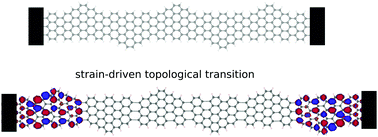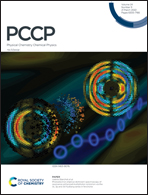Inducing a topological transition in graphene nanoribbon superlattices by external strain†
Abstract
Armchair graphene nanoribbons, when forming a superlattice, can be classified into different topological phases, with or without edge states. By means of tight-binding and classical molecular dynamics (MD) simulations, we studied the electronic and mechanical properties of some of these superlattices. MD shows that fracture in modulated superlattices is brittle, as for unmodulated ribbons, and occurs at the thinner regions, with staggered superlattices achieving a larger fracture strain than inline superlattices. We found a general mechanism to induce a topological transition with strain, related to the electronic properties of each segment of the superlattice, and by studying the sublattice polarization we were able to characterize the transition and the response of these states to the strain. For the cases studied in detail here, the topological transition occurred at ∼3–5% strain, well below the fracture strain. The topological states of the superlattice – if present – are robust to strain even close to fracture. The topological transition was characterized by means of the sublattice polarization of the states.



 Please wait while we load your content...
Please wait while we load your content...